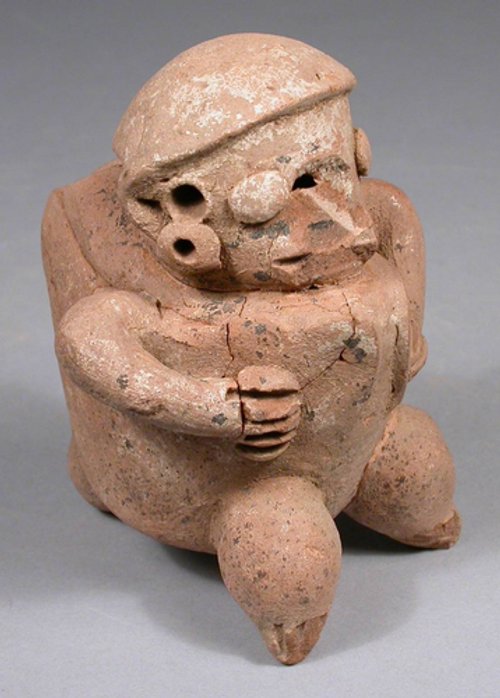Kleine, dreibeinige anthropomorphe Gefäßpfeife. Das hohle Objekt besitzt einen aufgeblähten Körper, der an zwei Seiten abgeflacht wurde. Die stehende Figur trägt eine runde Kopfbedeckung und Ohrringe. Sie besitzt am Hals zwei kleine, gegenständige Öffnungen, die wahrscheinlich zur Aufhängung dienten. Ein Bein wurde als Mundstück benutzt. Das Objekt ist geglättet, geschlämmt und grundiert. Die Grundierung ist fast vollständig erodiert. Die Keramik besitzt mehrere, geklebte Bruchstellen.
Das monochrome Objekt hat eine weiße Grundfarbe, die auf rötlichen Ton aufgetragen wurde. Die Figur scheint einen Buckel zu besitzen. Sie legt beide Hände auf ihren Bauch. Soziale Bedeutung: ähnliche Skulpturen wurden als Ritualobjekt (Bransford 1881; Bonilla et al. 1987), als Anhänger oder als Gefäßpfeife (Lehmann 1913) interpretiert. Nach Lehmann 1913: El Viejo-Stil. Lothrop (1926) bespricht die Keramik unter den Gruppen orange-brown ware figurines und red ware figurines.
Kulturelle Bedeutung: die Gruppe ist nur aus dem Süden der Region Gran Nicoya bekannt. Ihre Objekte wurden vor allem in Bestattungen dokumentiert. Die Keramik gehört zu einem Konvolut dekontextualisierter Objekte, die Lehmann im März 1908 in einem Gräberfeld bei El Viejo fand. Allein aus der Huaca A sollen 480 Objekte stammen. Sie umfassen neben Keramiken auch Beile, Reibsteine, Muscheln und “Grünsteine“. Letztere waren mit Körperbestattungen assoziiert.
(Künne 2004)
Sammler: Lehmann, Walter
en

